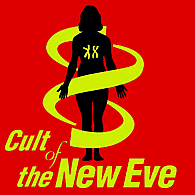Strange Culture
 Eduardo Kac's "GFP Bunny"
Eduardo Kac's "GFP Bunny"
Slate magazine has an online slide show this week about "bio art" — in which people use genetic manipulation to insert coded messages into DNA, or produce a transgenic rabbit using a gene derived from a jellyfish that makes it glow fluorescent green.
I was a little disappointed, though, that Slate failed to mention the work of Steve Kurtz, a bio artist whose work goes further than most in provoking debate about the ethical issues involved with genetic engineering — so far, in fact, that he is currently awaiting trial on charges that could land him in prison for 20 years.
 I happened to meet Steve Kurtz in December 2002 at a "World Information Organization" conference in Amsterdam, where we were both speakers. Kurtz spoke on the topic of "The Spectre of Intellectual Property Rights" and described his work as a performance art provocateur. To challenge corporate control of biotechnology, for example, his Critical Art Ensemble (CAE) produced an exhibit at the Corcoran Gallery of Art in Washington, D.C. called "Molecular Invasion." It consisted of a " live public experiment" that attempted to "reverse engineer genetically modified cash crops" by developing a chemical that can be applied to the Monsanto company's genetically-engineered Roundup Ready crops to make them vulnerable again to "the crippling effects of RoundUp herbicide." Another CAE project, "Free Range Grain," consisted of a mobile lab that invited the public to test foods for genetic modification. Another, more whimsical project that Kurtz showcased at the conference in Amsterdam was called "Cult of the New Eve" (CONE). It consisted of a mock religion that practiced "molecular cannibalism" by inviting people to eat bread and drink beer containing human DNA.
I happened to meet Steve Kurtz in December 2002 at a "World Information Organization" conference in Amsterdam, where we were both speakers. Kurtz spoke on the topic of "The Spectre of Intellectual Property Rights" and described his work as a performance art provocateur. To challenge corporate control of biotechnology, for example, his Critical Art Ensemble (CAE) produced an exhibit at the Corcoran Gallery of Art in Washington, D.C. called "Molecular Invasion." It consisted of a " live public experiment" that attempted to "reverse engineer genetically modified cash crops" by developing a chemical that can be applied to the Monsanto company's genetically-engineered Roundup Ready crops to make them vulnerable again to "the crippling effects of RoundUp herbicide." Another CAE project, "Free Range Grain," consisted of a mobile lab that invited the public to test foods for genetic modification. Another, more whimsical project that Kurtz showcased at the conference in Amsterdam was called "Cult of the New Eve" (CONE). It consisted of a mock religion that practiced "molecular cannibalism" by inviting people to eat bread and drink beer containing human DNA.
At the end of the conference, I had dinner with Steve Kurtz and some of the other participants. He told some funny stories, and I told a few myself. Neither of us knew at the time that his life was soon to take a strange turn that would lead to the FBI accusing him of terrorism.
His ordeal began on May 4, 2004, when his wife, Hope Kurtz, died in her sleep of a heart attack. Kurtz awoke to discover that she was not breathing and telephoned paramedics. After the ambulance came, police were summoned, alarmed at the things they found in Kurtz's home: laboratory equipment, samples of bacteria, and books on topics such as biological warfare. They raided the home wearing haz-mat suits, confiscating the computers, science equipment and other items that Kurtz used to create his unusual art. His wife's body was also taken, along with the family cat, and he was arrested on suspicion of bioterrorism.
Up until this point, the government's handling of the situation could be construed as a reasonable response to a suspected threat. But even after autopsies and lab tests showed that the items in Kurtz's home were harmless and played no role in his wife's death, the FBI went ahead anyway and attempted to prosecute him for terrorism. By this point they had to know that his work, while unusual, was a form of artistic expression designed to provoke debate. It shouldn't have provoked criminal prosecution. His case went to a grand jury, which declined to indict him on the terrorism charges, but that didn't end his ordeal. The feds succeeded in indicting him for mail fraud, on grounds that he and another university colleague broke some laws by shipping biochemical samples back and forth without following proper notification procedures. 
As matters currently stand — more than three years after the death of his wife — Kurtz is still trapped in legal proceedings, with a trial expected by summer of 2008. In the meantime, he has racked up more than $100,000 in legal bills and, on advice of attorneys, cannot speak publicly about his case while awaiting trial.
A documentary film about Kurtz is making the rounds, titled "Strange Culture." It was one of the films featured at the Human Rights Watch Film Festival currently happening in New York City. Since Kurtz cannot speak directly about his case, the documentary features actors playing the roles of him and his wife (with Kurtz himself commenting on their performances).
If you get a chance to see the film, you should check it out. As one reviewer wrote after watching it, "Serious issues of government overreach and the ability of artists to push the boundaries of what's legally allowable are at stake in Kurtz's case. As he himself points out at one point in the film, he's being put on trial for mail and wire fraud even though a) no party is claiming to be defrauded, and b) similar short-cuts were taken during major undertakings like the Human Genome Project, but no one chose to notice because that's just how things are done. Whether Kurtz's treatment is politically motivated is up to the viewer to decide, but after watching the film, any sensible person must conclude that whatever else he may be, this balding hippie eccentric is not a terrorist."





Comments
BOO frankenfoods! Hooray BEER!!!
Seriously, you only need to look at the picture to see why they're picking on him. It wouldn't surprise me if they put a turban on him for his trial.
I believe the issues raised here are so fundamental and far-reaching as to merit a constitutional amendment. Here is my proposal:
1. No person except a natural born Citizen, having Green-Glowing Jellyfish DNA, shall be eligible to the Office of President.
2. The words "natural born" shall not be construed as to include persons conceived by means of Artificial Insemination even if born within the United States by Vaginal Delivery.
3. The Congress shall have the power to ensure an adequate Population of eligible Candidates for the Presidency with appropriate Legislation, including the awarding of Contracts.